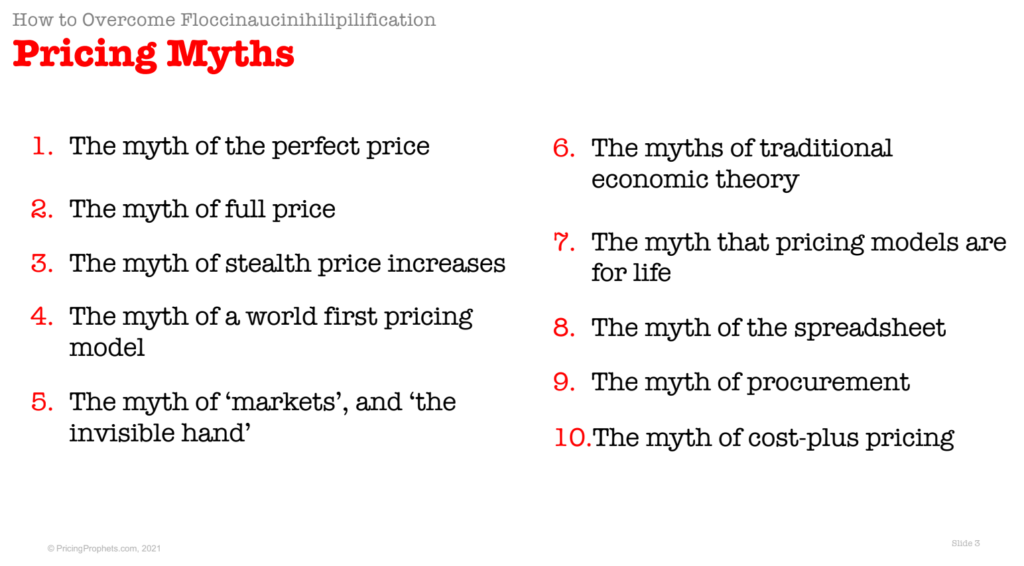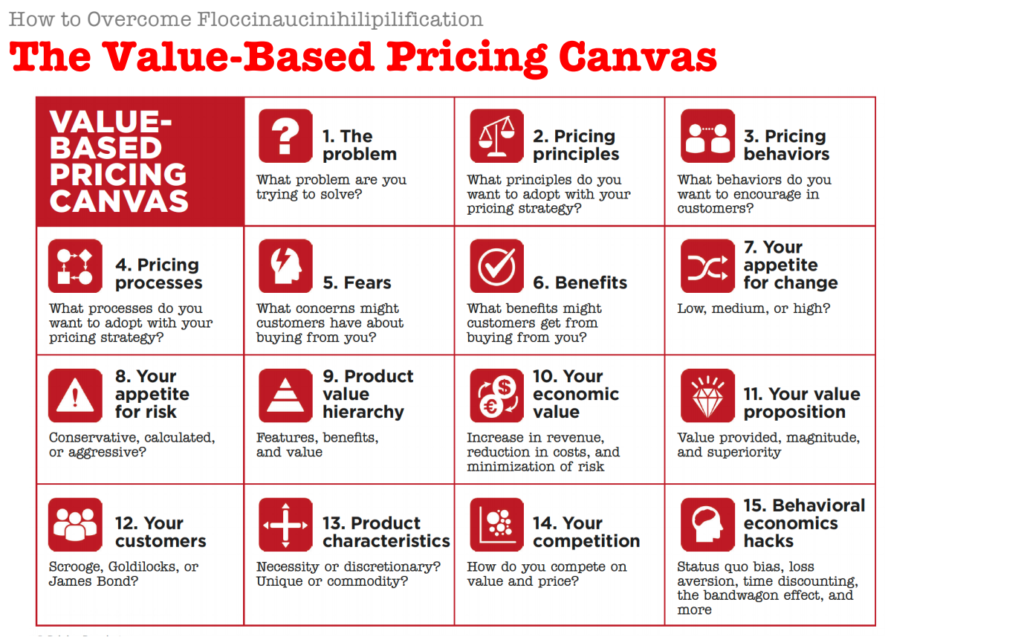One of the famous 7 Ps of product marketing is Price. As product professionals, we’re caught in the middle of a battle between trying to maximise price for our bottom line, while offering appealing value to the customer who wants to minimise their costs. Jon Manning showed that there are many myths in pricing, while giving great tips on options available when we are trying to price our products.
What does that big word even mean?
floccinaucinihilipilification
/ˌflɒksɪˌnɔːsɪˌnɪhɪlɪˌpɪlɪfɪˈkeɪʃ(ə)n/
noun
the action or habit of estimating something as worthless.
Top 10 Pricing Myths

The myth of the perfect price
There is no such thing as a perfect price. Everyone has a different understanding of what they are willing to pay and how that payment should be structured. So pricing depends on each individual, and there will not be a single price or model that suits everyone.
The myth of full price
In certain hotels, they are obliged to outline their ‘rack rates’ – what the company specifies as the default rate for the room. You could often find it behind the door. However, nobody pays rack rates in hotels any more. Instead, we use discount sites as we want to get a great price – to get the “The thrill of the kill”. As a result discounting has to be a strategic part of pricing.
The myth of stealth price increases
Stealth price increases just don’t happen as much as we think. Thanks to social media, when people discover them they give immediate feedback to the vendor. One example is the drug Daraprim that went from US$13.50 to US$750 per tablet overnight and was immediately picked up by the media.
The myth of a world first pricing model
Some people believe that they have just invented a brand new pricing model and that nobody else has done it before. The reality is that all have been done in some way in the past. For example, Uber surge pricing model was just what the airlines did in the 1970s. During the great fire of London, the boatmen evacuating people across the Thames actually tripled their fares.
The myth of ‘markets’, and ‘the invisible hand’
Prices are not set by some sort of invisible hand – they’re set by real people.
Prof. Mark Ritson of London Business School said: “Pricing is the worst managed of all marketing areas. How prices are decided is often a mixture of voodoo and bingo.”
The myth of traditional economic theory
Traditional economic theory talks about price elasticity as when prices go down, the quantity of demand goes up. However, we never see this perfect price elasticity.
The myth that pricing models are for life
Our pricing models need to evolve. For example, many of our purchasing these days is by subscription model. Or how engines on planes are no longer charged by unit but are charged for power provided.
(Though with 90% of the world’s fleet on the ground this model is probably making it a bit tough for the engine manufacturers).
The myth of the spreadsheet
Every pricing model is in a spreadsheet without fail. However, this is just a simulation and not what happens in the real world.
The myth of procurement
Working with a Procurement team is like a frenemy; both friend and enemy to agreeing on a deal. You need to understand how they work – for example spend time with Procurement to learn how they beat up vendors on price. Then build this approach into your pricing model
The myth of cost-plus pricing
Customers don’t care about how much it costs you to produce – they just care about the value for them.
Why is pricing so important?
Pricing has a huge impact on operating profit. A 1% improvement in price can lead to an 11.1% increase in operating profit – a much better ratio than improving fixed costs, volume or variable costs.
Apple has many fans despite their price. Their strategy has sensitized their customers to the value they bring, over the price they charge. Which means they can take the discussion away from price
However, not everyone is really thinking through their pricing. Startups are filling in their business model canvas, and thinking about migrating their users from eyeballs to customers, but they are not thinking through their actual revenue.
The Value-Based Pricing Canvas

This canvas gives you 15 pricing questions designed to get you thinking about the value your provide. For example is it better to have no-hidden-surprises pricing, or dynamic pay-as-you-go pricing? Organisation and customer behaviors are driven by pricing so it is best to have this clear.
A blank canvas is available on the pricing prophets website
Value based pricing methodologies
Van Westendorp’s Price Sensitivity Meter
This is a Value-based approach because you have to talk to customer, rather than an ivory tower exercise. You ask customers four questions in surveys:
- At what price does the product look cheap
- At what price does the product look expensive
- At what price does the product look too expensive
- At what price does the product look too cheap
You can then plot these on chart and a box forms that helps determine an optimal price band.
Customer Value Analysis
This gets customers to value each attributes of your product, assign weights, and get an overall measure of customer value.
- Identify value attributes from a customer perspective
- Get customers to weight the product value attributes
- Get customers to assess the product value attributes
- Benchmark products against each other
- Plot findings on a value map
This overall measure of value can also be used to generate a price
Software as a Service (SaaS) subscriptions

This is now the classic startup pricing approach.
- Define the architecture of your products
- Define the operational stuff the product actually does
- Define the non-operative features, because it adds further differentiation
- Consider the optional extras, for example things that are included in one product, but not in an another
- Consider your segmentation, what each segment is willing to pay and whether it caters for all your customers and personas.
How do you choose your pricing model?
Choosing a pricing model is a combination of many factors; including analysis, experience, and sometimes you just know.
Many products are just naturally heading towards the SaaS model – it feels like a silver bullet for most online products.
However there are some increases in the number of companies using usage based pricing only; Snowflake, Stripe and Twilio. These companies are growing faster than other SaaS companies.
Our Speaker
Jon Manning has vast experience in value-based pricing, gained in technology, and a range of other industries. He is a two-time past presenter at Product Camp.
His career has been a journey through three other pricing methodologies: the mysterious pricing of the oil industry, cost-plus pricing in the catering industry, and dynamic pricing in aviation and other services industries.
Check out Jon’s new book, Floccinaucinihilipilification, available on kindle & paperback at Amazon
Our Sponsor
Thank you to A Cloud Guru for being an amazing sponsor! ACG is teaching the world to cloud – and currently hiring! https://acloudguru.com/careers
Coming next
In March we have a few sessions in the works! We’ll be co-hosting the LTP Pitchfest on March 18th and then we’re hoping to be able to meet face to face on March 30th for a session on improv. Plus, there may be dumplings!
Resources
